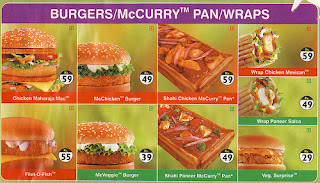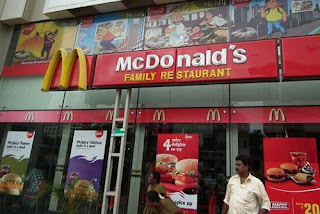Introduction
Since the opening of Indian business space for foreign trades as
part of landmark reforms in 1991, many multinational companies have come to do
their business in the country. One such company has set its shop in the Indian
soil is McDonald’s, the multinational Fast Food Giant. The company established
itself as the seller of American fast food in 1996. Since its inception in
India, it had established 212 outlets in the country by early 2011. Since
more companies joined the fray to get the Indian business space in the fast
food industry, McDonald’s had to evolve strategies to woo the Indian customers
by understanding the Indian cultural sensibilities and their appetite.

Tailor-made Products
The company has presence in over 119 countries through as many as
31000 eateries. It was able to resolve a dilemma – bringing global standards or
adopting local tastes and preferences. That was the reason why it could have a
global presence in a short span of time. For instance, it developed Arabian
flat bread in Kuwait City, McLaks for fish-loving customers in Norway and a
Rice burger for the food lovers in Hong Kong. This business acumen and
developing new items for consumption has endeared the fast food giant with its
customers across the globe. Apart from this, the fast food chain has been able
to project itself as the most sought after family restaurant in the country. To
enhance its appeal as the family restaurant, highly trained staff maintains
high cleaning standards in its corridors, kitchen and serving rooms. Also
the serving trays and utensils are cleaned several times in an hour to ensure
the high standards of cleanliness.
Products for Indian Condition
In line with this thought, McDonald’s had introduced a new
marketing campaign that went viral in 2011. It primarily consisted of TV
commercial and in-store promotions. This campaign was to support the
launch of Mac Spicy products to woo the Indian customers. The idea was to add
more variety to the company’s menu to suit the Indian customers’ tastes. These
menu items were largely taken from its core global menu, but tailored to tingle
with the Indian taste buds. In addition to this, the fast food giant had
overcome what the analysts termed at that time – ‘snack joint tag’ - in India,
by introducing a lunch and dinner menu to sync with the Indian customers.

Pricing Strategy
The multinational companies come with the ages-old concept of
adapting to the local conditions. Indian customers are known for spending
thriftiness as many of them hail from the middle class background. In keeping
with this customer mentality, McDonald’s has come with the concept of value
pricing for its priced Indian customers. For its Indian customers, mainly
the fast food major has come out with Happy Meals, Medium meal combo, Maharaja
Meal and Family Dines. These cuisines are offered at very attractive and
competitive prices across the country. This comes under the product-line
pricing, targeting the middle class customers and families in particular.
For example, you can order a “Two Cheeseburger Value” meal for Rs. 75. It
comes with a medium drink and fries. It also provides “Super Size” meal for a
higher amount that comes with a large drink and a large bowl of fries. The
customer has the option of going for another “Value” meal with other
combinations on offer.
Place and Distribution
McDonald controls the product price by its unique business model.
Of the total business volume, only 15% is controlled by its eateries. The
remaining 85% is controlled by a network of franchises in India. Apart
from this, the addition of the franchisee network helps the fast food giant to
establish a framework of training and monitoring. This in turn enables them to
stick to superior quality in service, and higher degree of cleanliness and value
propositions. This franchisee network also adds the scope for experimenting
with the locally available cuisine to add to the McDonald's list of offer to the
customers. The franchises also ensure the timely delivery of the products
ordered by the customers either by phone or by casual visit. Moreover, the
children are given special incentives in the form of small toys or figurines
when their parents buy the fast food items from the company’s eateries.
Promotion
McDonald undertakes steps to reach out to its target customers in
the Indian context by means of advertisements, online campaigns and short-time
videos on the customer experience and ambience of the restaurant. The online
campaigns in the form of videos and brochures are sent to the target customers
to get their attention. The TV advertisements and the social media campaigns
are also run to educate the food lovers about different options available for
them. Throughout the area where the eatery is located, the billboards and
posters are displayed to tell the people about the proximity of the McDonald
restaurant. Now-a-days, the mobility platform is used to a large extent to
reach out to the tech-savvy people through SMS, MMS and other means.
India-specific Business
In the Indian context, the company discovered the local flavours
like “Value Meals” and “Combos” to win the heart of the people. Moreover, the
cleanliness of the restaurant – both inside and outside – and the children’s
section helped it to win over the families. This operation model is adopted to
help the fast food major to control the prices of the products offered and, at
times, reduce their prices to attract more customers to its fold. The marketing
campaigns, both online and offline, have helped the people educated about the
range of offers it has to give its customers. This is the reason why India has
become a good customer base for the McDonald’s.
Summary
McDonald has evolved into a true multinational company by adopting
the local conditions of different countries. Despite fanning out to various
countries, the core products for which the fast food major was famous for is
retained and adding more of the local flavour to win over the food-loving
people. The American company was able to do this due to the establishment of
franchisee networks in different countries and experiment with local flavours.











0 Post a Comment:
Post a Comment